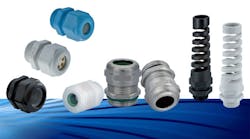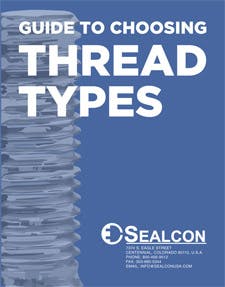Liquid tight strain relief fittings provide protection to the wires and cables from stress, damage and outside elements when attached to a panel.
Often when a cable is used the electrical connections inside the equipment are made to a terminal block with solder connections or a connection with some form of termination.
A strain relief can be used to eliminate any tug or pull on the cable that could cause the wires to become disconnected, resulting in the electrical failure of your equipment. These fittings can also be specified to provide additional protection when the cable is under continuous movement in dynamic situations which can cause potential problems such as abrasion or kinking on the outer jacket of your cable.
Visit sealconusa.com to learn more about liquid tight strain relief fittings.
In choosing the correct strain relief for your application, there are six important application issues to consider:
1. Method of Attaching the Cable
Attaching the cable refers to how the strain relief is assembled with the cable. A standard strain relief slides onto the cord and then the dome cap is tightened. A strain relief also has a form seal that seats into the body of the fitting and clamping splines. Clamping splines apply a concentric pressure around the form seal and cable and prevent the cable from being pulled out of the fitting.
2. Material
The Strain Relief material is offered in:
- Nylon
- Nickel Plated Brass
- Stainless Steel (303 / 316L)
- PVDF
These materials make this a very versatile option for a number of applications. For instance PVDF does not retain oil, harsh chemicals and also can be used in extreme temperature applications.
3. Mounting
There are two methods of attachment to a panel. The liquid tight strain relief’s are threaded and can be provided with or without a locking nut.
The first option is to tap or have an existing threaded hole to fit the strain relief into the panel.
The other method is to determine the diameter of the cut-out hole and use a strain relief which is close to the size of the hole and then secure it with a lock nut to the panel wall.
Both of these methods can provide a watertight seal if used with the O-Ring for the threaded version and a Seal Ring for a cut-out hole.
4. Choosing a Body Style
Specific body styles are available for many different applications. Typically Strains Relief’s are available in two general configurations:
- Dome Top Strain Reliefs are designed to protect the wire at point of entry. Are ideal for static installations. They help to secure the wire connections to the equipment and provide longer life to the cord by preventing it from rubbing against a ruff or sharp edge when the cord passes through the panel.
- A Flex top (Pig tail) Strain Relief provides additional support and protection against kinking, chafing and extreme sudden bends at the point of entry. These are ideal for dynamitic installations. The spiral flexing portion of the strain relief supports the movement of the cable. Flex styles are more suitable where the products are intended for dynamic applications.
- 90 Degree Angle Strain Reliefs are available for applications where the cord must fit in a 90 degree bend or a narrow space between the equipment and a wall. Both the Flex and dome styles can add strength and support to the cable and minimize wire strain in a bending application.
- Multi-Hole Strain Reliefs are also available for wire harnesses and hook –up wires. These multi-hole strain reliefs allow for one or more individual conductors to pass through multiple holes of a fitting. There are at least 300 variations from the number of holes to choosing the type of strain relief material suitable for the application.
- Custom solutions are also offered using a solid Elastomer plug that can be custom drilled to a customer’s specification for almost any configuration. We not only offer parts but solutions. Here is an example shown of a solution for a terminated end on a cable:
First ...you drill the hole size of the cable in a solid plug and then carefully implement a slice from the hole to the edge of the plug.
Secondly measure the terminated end at the widest point and measure the strain relief opening, this will ensure that the terminated end can easily feed through the fitting.
You then affix the Elastomer plug around the cable jacket and then feed it back into the body of the strain relief fitting and then lastly tight the cap.
- Additionally there are factory Inserts available with special shapes that will accommodate flat cables and parallel cables applications.
- High Performance clamp is another unique part that is offered. This fitting offers maximum pull out resistance. Notice that the clamp is attached to the strain relief fitting which will provide an extra grip on a cable when there is exerted force.
- Finally our EMI/RFI Metal Strain Relief allows the cable to terminate on both the shielding of a shielded the strain relief and the Chassis. This effectively prevents EMI and RFI noise from entering or radiating through the hole in to the Chassis and mounted strain relief. These are offered in two styles, an FE feed through and BE standard:
The FE option is fairly easy to assemble and only requires stripping the jacket to expose the shield which can be a foil or braid. Slide the fitting over the cable and exposed shield and tighten the dome nut. The contact legs will then touch the exposed wires and you will have contact.
The BE option is a bit more labor intensive. First you strip the cable jacket Secondly feed the braided cable through the nut and clamping insert. Then fold the braided shield back over the O Ring which is attached to the insert. Make sure that the braided shield overlaps the O-ring by 2mm.
Lastly push the clamping insert into the body of the strain relief and then tighten the dome cap. Optional Locking nuts with cutting edges are also available. They slice through paint coatings on metal enclosure to ensure grounding and are suitable for vibrating applications.
5. Outer Diameter
Cable size is extremely important when specifying a strain relief fitting. The outer diameter of the cable must be known in order to select the appropriate fitting.
Look at the cable range being offered and know your cable OD, match your OD within the upper cable range of the strain relief fitting. This will allow the strain relief to be tighten on the cable quickly, easily and assure that there's plenty of room for adjustment if further tightening is needed especially for a softer cable jacket.
6. Thread Type
There are primarily three different Threads Types to choose from:
- NPT is long and tapered and a standard used in North America
- PG is short and straight and is known as a European standard
- Metric is also short and straight is used Worldwide
Just think a metric thread could give you the freedom to spec in a strain relief for your equipment and it could be used in every country, all over the world.
For an in depth review of thread types, visit Sealcon for a free guide covering the characteristics and benefits of each thread type option.












